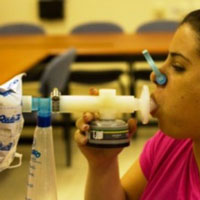| Posted: Jun 18, 2014 | |
Breathalyzer test with nanotechnology chip may detect deadliest cancer |
|
| (Nanowerk News) Lung cancer causes more deaths in the U.S. than the next three most common cancers combined (colon, breast, and pancreatic). The reason for the striking mortality rate is simple: poor detection. Lung cancer attacks without leaving any fingerprints, quietly afflicting its victims and metastasizing uncontrollably — to the point of no return. | |
 Now a new device developed by a team of Israeli, American, and British cancer researchers may turn the tide by both accurately detecting lung cancer and identifying its stage of progression. The breathalyzer test, embedded with a "NaNose" nanotech chip to literally "sniff out" cancer tumors, was developed by Prof. Nir Peled of Tel Aviv University's Sackler Faculty of Medicine, Prof. Hossam Haick (inventor) of the Technion — Israel Institute of Technology, and Prof. Fred Hirsch of the University of Colorado School of Medicine in Denver. The study, presented at a recent American Society of Clinical Oncology conference in Chicago, was conducted on 358 patients who were either diagnosed with or at risk for lung cancer. The participants enrolled at UC Denver, Tel Aviv University, University of Liverpool, and a Jacksonville, Florida, radiation center. Other researchers included Prof. Paul Bunn of UC Denver; Prof. Douglas Johnson, Dr. Stuart Milestone, and Dr. John Wells in Jacksonville; Prof. John Field of the University of Liverpool; and Dr. Maya Ilouze and Tali Feinberg of TAU. The smell of cancer |
|
| "Lung cancer is a devastating disease, responsible for almost 2,000 deaths in Israel annually — a third of all cancer-related deaths," said Dr. Peled. "Lung cancer diagnoses require invasive procedures such as bronchoscopies, computer-guided biopsies, or surgery. Our new device combines several novel technologies with a new concept — using exhaled breath as a medium of diagnosing cancer. | |
| "Our NaNose was able to detect lung cancer with 90 percent accuracy even when the lung nodule was tiny and hard to sample. It was even able to discriminate between subtypes of cancer, which was unexpected," said Dr. Peled. | |
| Lung cancer tumors produce chemicals called volatile organic compounds (VOCs), which easily evaporate into the air and produce a discernible scent profile. Prof. Haick harnessed nanotechnology to develop the highly sensitive NaNose chip, which detects the unique "signature" of VOCs in exhaled breath. In four out of five cases, the device differentiated between benign and malignant lung lesions and even different cancer subtypes. | |
| The bigger the tumor... | |
| "Cancer cells not only have a different and unique smell or signature, you can even discriminate between subtypes and advancement of the disease," said Dr. Peled. "The bigger the tumor, the more robust the signature." | |
| The device and subsequent analysis accurately sorted healthy people from people with early-stage lung cancer 85 percent of the time, and healthy people from those with advanced lung cancer 82 percent of the time. The test also accurately distinguished between early and advanced lung cancer 79 percent of the time. | |
| "The device could prove valuable in helping determine patients who need more intensive screening for lung cancer," said Dr. Peled. "We're hoping to have a device that would be able to give you a go/no-go result — something's wrong, go get an X-ray." | |
| The Boston-based company Alpha Szenszor has licensed the technology and hopes to introduce it to the market within the next few years. Meanwhile, a new, smaller version of the device has since been developed that can plug into a computer's USB port. | |
| The study was supported by the European Union LCAOS grant, an EU-funded collaborative whose aim is to enable the earliest possible detection of lung cancer, and the International Association for the Study of Lung Cancer (IASLC). | |
| Source: American Friends of Tel Aviv University |
